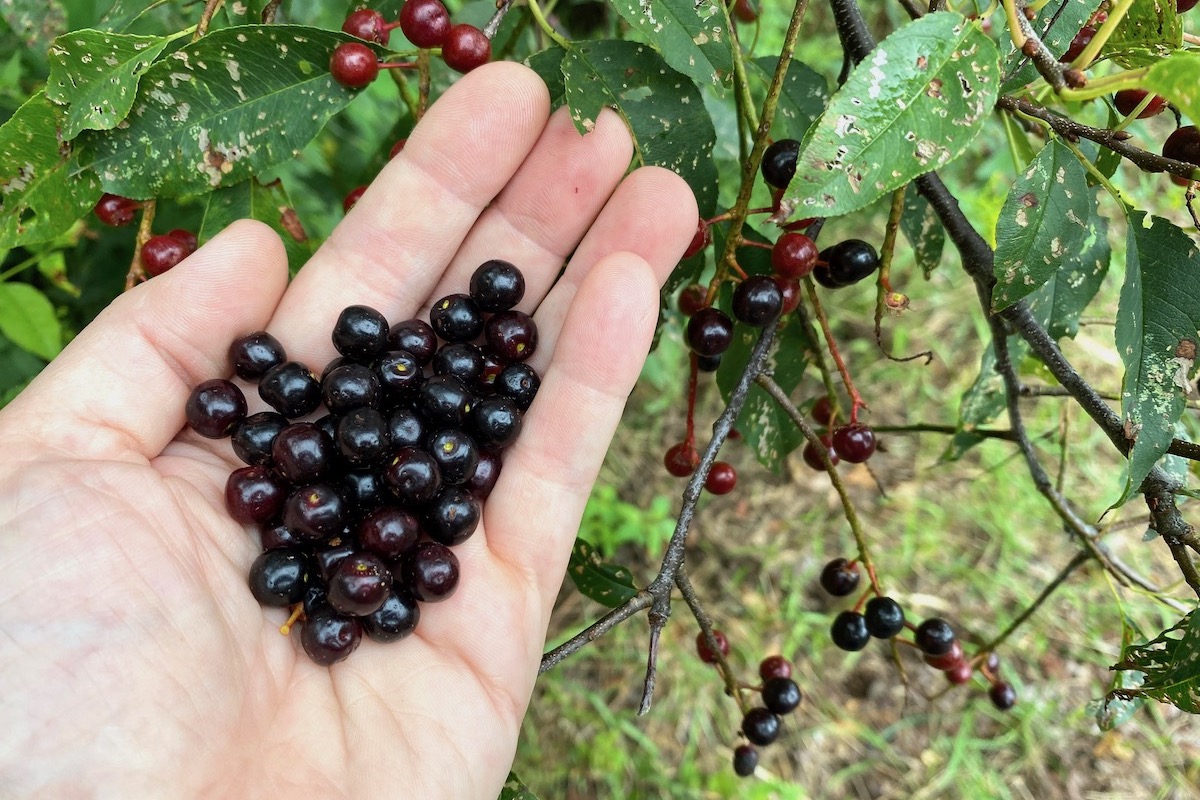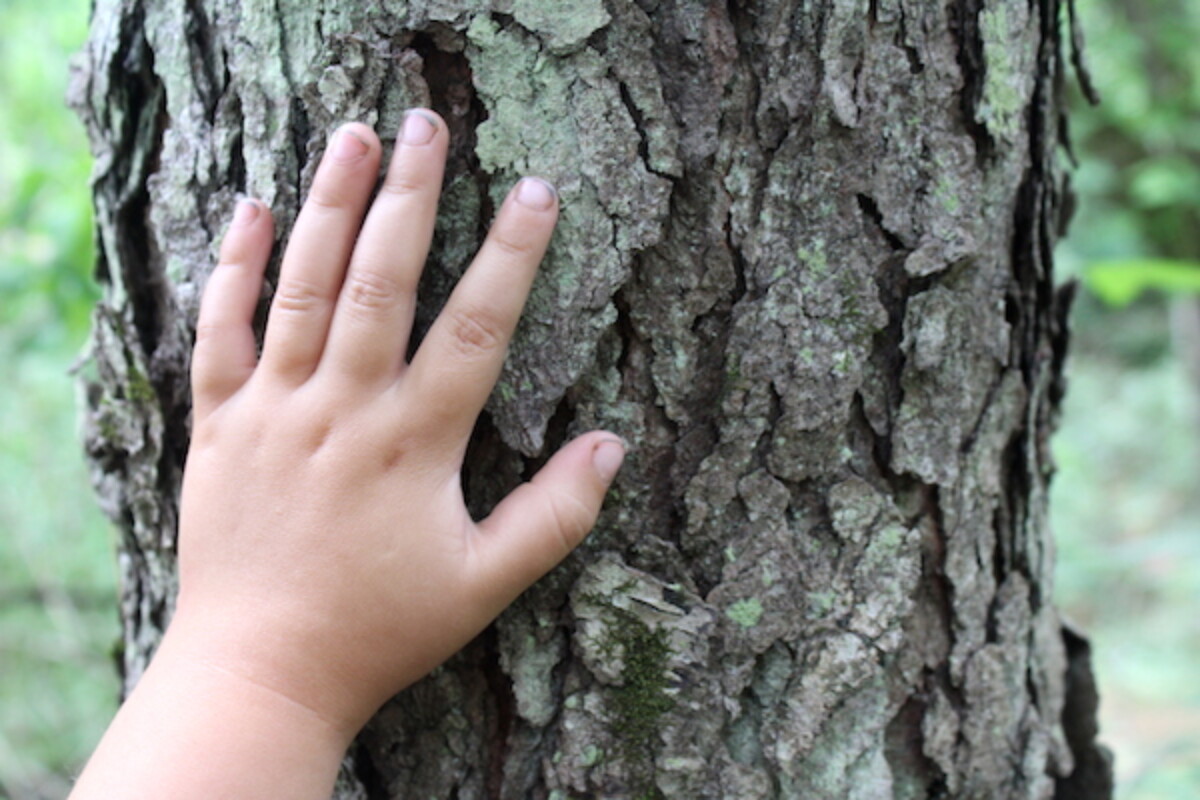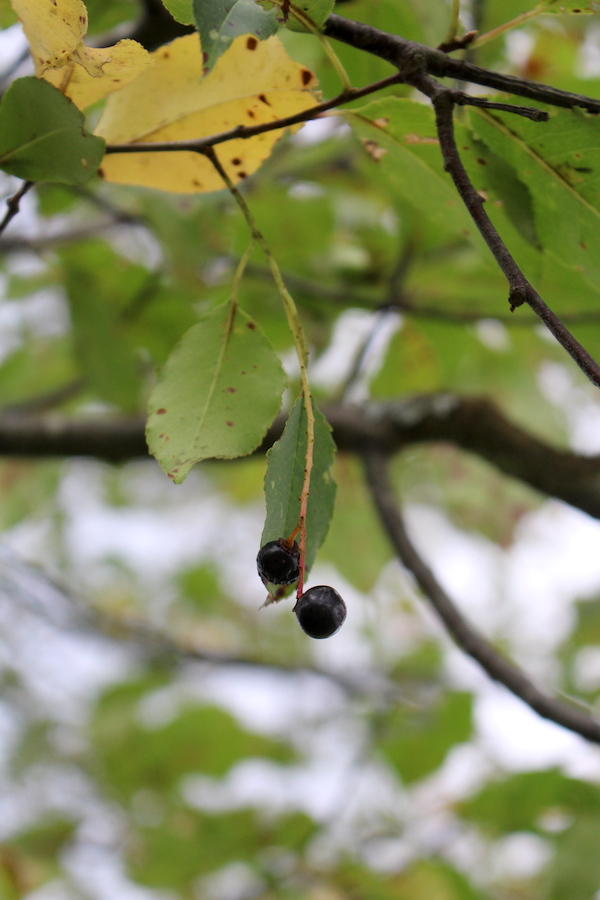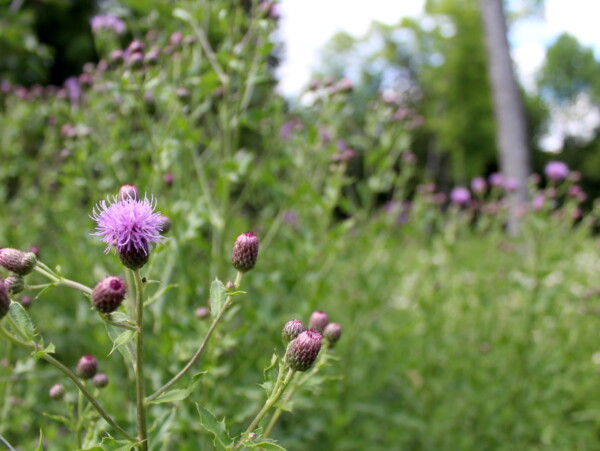Affiliate disclosure: This post may contain affiliate links. Please see our Privacy Policy.
Wild Black cherry (Prunus serotina) are absolutely delicious, and one of the best wild fruits available anywhere. They taste more or less exactly like cultivated sweet cherries (though they’re smaller), and can be harvested over a wide range in the US.

Wild black cherry is a choice edible wild fruit that’s sweet and delicious, with no hints of the bitterness you’ll find in chokecherries or tart flavor in pin cherries. Honestly, they’re not all that different than cultivated sweet cherries in flavor, with that deep, rich red-wine-like complexity you’ll find in a perfectly ripe bing cherry.
It’s sometimes referred to as “chokecherries’ better cousin” because the fruit look quite similar, but black cherry has a number of characteristics that just make it better (at least to human tastes).
- Black cherries are sweeter, without the astringency that gives chokecherries their name
- Black cherries are freestone, meaning they don’t cling tightly to the pit like chokecherries
- Black cherries grow on large trees that produce huge crops, they can literally be harvested by the bucket full
The main downside of black cherries, however, is they do in fact grow on full-sized trees. While you can watch a full tree come into flower in the spring, with the promise of gallons of fruit later, often the fruits are high up in the canopy where they’re picked off by birds just as they ripen.
At least, that’s what happens in the forest usually. In edge areas, the trees tend to stay shorter, and develop multiple trunks. If you search along the edge of the woods where deer aggressively browse, or near hayfields where mowers might clip the trees a few years just as they’re getting started, you’re likely to find black cherry trees perfect for human harvesters.
The fruits of wild black cherry trees are smaller than cultivated cherries, but what they lack in size they make up for in flavor. They’re well worth the effort!

Black Cherry Range
Wild black cherry can be found all along the East Coast of the US, into southern Canada and south as far as Central Florida. They range west into the Central US, reaching into East Texas and just past the great lakes.
There are isolated pockets in the southwest and down into Mexico. This covers their main concentrations, and there are likely stands other places as they’re quite adaptable and easily spread by birds.

Identifying Wild Black Cherry
Wild black cherry trees can vary in shape and growth habits, depending on how they’re treated when young. If cut off repeatedly (be deer or mowers at the edge of a field) they’ll stay relatively short and bushy, with multiple trunks. If allowed to grow freely, they’ll become tall straight trees with thick shaggy trunks.
Though they’re beautiful stately trees when tall, it’s almost impossible to harvest fruits from the high canopy. Those black cherry trees will be food for the birds.
Those with coppiced trunks at the edges of fields will fruit when branches are still low to the ground, as they’re the same age as the larger ones, just with multiple smaller trunks and easy-to-reach branches.

Black Cherry Bark
As black cherry trees age, their distinctive bark changes as well. When young, the bark is lenticular or has horizontal stripes that look like tiny scars. That’s quite similar to other wild cherry species, namely chokecherry.
Chokecherry will keep this bark forever, as it never really grows out of its busy size and shape. Black cherry, on the other hand, will eventually develop plated shaggy bark.
You can see the progression in bark color and texture below, with the youngest tree at the top left and the oldest at the bottom right, just as it’s fully transitioned to shaggy mature bark (though the tree is still relatively small).

Black cherry trees are easy to find in a mature forest, even when you can’t see their tops and leaves. Just look for their shaggy plated bark and you’ll easily be able to find their trunks.
Sadly though, that doesn’t often help you actually harvest black cherries. Usually, when their trunks look like this they’ll be huge trees, with their lowest cherries more than 50 feet up in the air.

I’ve seen people collect wild black cherries from under these stately trees, as they drop to the ground. The Townsends actually have a video of them harvesting them from the ground under centuries-old black cherry trees.
Honestly, I’ve never seen black cherry fruit hit the ground (and I’ve been looking for a decade). The birds snap these tasty little fruits up quick, and at least here in the North, they’re determined enough to never let them fall.
(The Townsends are in the south, so maybe the trees make more fruit or the birds are distracted by other things.)
If I want to harvest wild black cherry, I look for trees near the edges of hayfields or right at the edge of the woods, where they’ve been mowed a few times when young (or trimmed off by deer). This treatment when young means they develop multiple trunks and a more bush habit, so they’ll fruit closer to the ground.

Black Cherry Leaves
The leaves of black cherry trees have that typical stone fruit shape, and they look a lot like cultivated cherries (or peaches, plums, etc). They’re long and narrow, with a central vein and mildly serrated edges.
They look a lot like other wild cherry species too, namely pin cherry and chokecherry.

In general, chokecherry leaves are a bit wider and shorter. They look more rounded and less long.
That’s not a hard and fast rule though, as I’ve seen considerable variation in different wild black cherries and chokecherries. Each one has a slight difference, and some black cherry leaves are shorter, while some chokecherry leaves are longer.
Still, in general, that’s true, but not a sure-fire way to tell if you’ve got one versus the other.

Wild Black Cherry Flowers
Black cherries flower in racemes or flower spikes, unlike cultivated cherries which put out flowers individually. That’s the easiest way to tell these from pin cherries, which bloom in clusters.
Unfortunately, chokecherries also put out flowers in racemes, and the flowers look quite similar. Generally, though, chokecherries flower about 2 weeks earlier than black cherries, and they flower on very small shrubs. I’ve seen 6” tall chokecherries actually send out a flower spike, though they’re usually more like 4′ to 6′ bushes.
Black cherries generally don’t flower until they’re 15′ to 20′ tall (if coppiced and multi-trunked) or over 40 feet if a single-trunked forest tree.
I cant seem to find my black cherry flower pictures, but I’ll take a few this season and add them in. They really are stunning, and fragrant.
Black Cherry Fruit
The fruit of wild black cherries is truly exceptional, and it ripens with a sweet, deep flavor that’s very much like cultivated bing cherries. They’re smaller, of course, but no less flavorful.
Though the fruit grow on racemes coming from one central flower cluster, they ripen individually. This is because they’re largely picked off by birds up in the canopy, so there’s no incentive to ripen together.

Chokecherries, on the other hand, are harvested by mammals in clusters (raccoons, bears, etc). They pull the whole raceme of fruit when ripe and stuff it into their mouth whole.
Those have an incentive to ripen together, so they do.
Below I’m holding a cluster of just barely ripe chokecherries (and a leaf) up next to wild black cherries still ripening on the tree. Chokecherries generally flower about 2 weeks earlier, and ripen a few weeks earlier too, all together in clusters.
That’s not universally true, as they ripen over a long season, often lasting 2 months or more. But still, the first chokecherries will ripen before the first black cherries, and often chokecherries are completely done and gone before you get a black cherry crop.

One thing I particularly love about wild black cherries, besides the fact that they’re sweet without any of the astringency of chokecherries, is that they’re freestone.
Chokecherries have flesh that clings to the seed and traditionally they were eaten with the seed since separating them is really quite tricky. They were pounded into chokecherry cakes to dry in the sun, and the sun denatured the toxins in the pits.
Black cherries, on the other hand, do not have such a tradition because their fruit is naturally separate from the pit. Though, it is still a very thin layer around a relatively large pit.

What’s the difference between Black Cherry and Choke Cherry?
So after all that, how do you tell the difference between black cherry and chokecherry?
They are both edible wild fruits, but it can be nice to distinguish between the two since their flavor, harvest and uses are somewhat different.
Here are some general differences:
- Chokecherries fruit as bushes, usually fruiting and flowering between 4 and 10 feet tall. Black cherries are trees, and fruit when at least 12 ft tall (if multi-trunked) or much taller if single-trunked.
- Chokecherries have rounded leaves with less of a point at the end, while black cherries have a long narrow leaf with a distinct point.
- Chokecherries flower and fruit a few weeks earlier.
- Chokecherries ripen in clusters, while black cherries grow in clusters but then ripen individually.
- Chokecherries are clingstone, while black cherries are freestone.
- Chokecherries have a pronounced astringency, while black cherries are just sweet with a deep wine-like cherry flavor.
That’s all a bit variable though, and some chokecherries are sweeter than others. Some have longer leaves, and some fruit earlier and later. That’s the trick with wild fruit, they’re wild and they can do what they want.
There is one sure-fire way to tell them apart though, and that’s the tiny bract on the fruit. Chokecherries have fruits that attach simply to the stem, like cultivated cherries.
Black cherries, on the other hand, have a star-shaped bract at the fruit attachment site.

This 5 pointed star-shaped bract is present at all stages of the development of the fruit, so you can ID a black cherry anytime it’s in fruit.
At least as long as the fruit are attached to the stem.
The bract will naturally fall away after they’re picked, which is nice since it makes them easier to eat, but also makes it hard to know what you’ve got if you’ve picked a basket of fruit. The fact that black cherry’s ripening time only barely overlaps with the last chokecherries helps a bit, but they still do overlap.
Below I’m holding a ripe black cherry and ripe chokecherry together, so you can see the bract. In the second picture, the bract has come free and is just on my hand.

Wild Black Cherry Look-Alikes
In general, wild black cherries are a safe choice for beginning foragers because they don’t really have any close look likes (besides chokecherry, which are also edible).
That said, I’ve seen people optimistically misidentify all manner of wild fruits, really anything even vaguely the same color and shape no matter where it’s growing.
Black cherries do superficially resemble other wild edible fruits, namely:
- Pin Cherries – The trees are similar, though pin cherries are short-lived and fruit young. The fruits are born individually and ripen to a bright red in early summer (months earlier than black cherry). They’re also edible, though sour like cultivated pie cherries.
- Aronia – Also called ChokeBERRY, I constantly see people misidentify these as ChokeCHERRY. Given that chokecherry is a look-alike, I might as well mention these. They grow on bushes, and flower/fruit in clusters (not racemes). They do not have a large stonefruit seed inside, instead of several small seeds, and they have a puckered end that looks unfortunately like a butt. They also grow on short bushes, not trees.
As for toxic black cherry look likes, I’ll call out buckthorn as a possible problem. It has black fruit that ripens on a tree at about the same time, though they’re born individually close to the branches rather than on racemes.
They also have multiple small seeds, rather than a single large one. The leaves and trees look different, and buckthorn has many sharp thorns. Still, the fruit is about the same size and shape and will cause some nasty stomach upset.

I’d also watch out for Canadian Moonseed, which is a vine but it climbs trees regularly. It looks a lot more like wild grapes, with crescent moon-shaped seeds inside, but it might be technically possible to confuse them with black cherries if you really casually harvested clusters.
Wild Black Cherry Recipes
Once you’ve correctly identified wild black cherry, how do you use it?
Honestly, I just eat them out of hand in season, like any other cherry. They’re delicious fresh and spitting the raw seeds out on the landscape helps ensure the next generation of this spectacular wild fruit.
Some people make them into wild cherry jelly, which is tasty too. I make chokecherry jelly without pectin, and those have quite a bit more pectin than wild black cherries.
If you do choose to make jelly from wild black cherries, I don’t suggest trying without pectin. You’ll end up with a fruit syrup, which is delicious, but definitely not a jelly.
I don’t have a specific wild black cherry recipe on the site, but you can use my grape jelly recipe. Just extra the juice by simmering (as you would with grapes) and then strain out the seeds. Your yield will be different obviously, so measure the juice and go from there.
Since they are freestone, you could, at least in theory make wild cherry jam…but that’s an act of real devotion. You’d have to pit literally a bucket of them by hand to get enough pulp since the seeds are so big.

They really can be used anywhere you’d use cultivated cherries, provided you pit them. Since that’s such a pain, I’d recommend using them where they’re either juiced or infused.
Be aware that most “wild black cherry” recipes on the internet are actually just cherries, the wild is just added by marketing companies that think that a packaged hand pie, lollypop, or gumball will sell better that way.
Here are some recipes actually made with wild black cherries:
- Wild Cherry Whiskey (Louis and Clark’s Recipe)
- Wild Cherry Cordial
Beyond just using the berries, wild black cherry bark is medicinal and it’s traditionally been used as a cough remedy. The process for making it is rather specific, but you can find details on how to make cherry bark cough syrup here, plus how to use it.

Wild Fruit Foraging Guides
Hoping to find more types of wild berries and fruit this season?
Wild Food Lists
Not sure what else to look for in the wild? Here are a few ideas:
- 40+ Edible Flowers
- 50+ Edible Berries and Fruits
- 20+ Wild Edible Roots, Tubers, and Bulbs
- Winter Foraging: 50+ Things to Forage in Winter
- Spring Foraging: 20+ Things to Forage in Spring
- 12+ Wild Edible Mushrooms for Beginners
- 16+ Mushrooms to Forage in Winter















Thank you, thank you, thank you!! Thus is the most comprehensive information I’ve found on wild black cherries. Even more helpful than my state extension/master gardener. I just discovered wild black cherries growing on my property this summer, after living here for almost 20 years. I would love to harvest these and make into a syrup. Can you provide me with any guidance or recipe? I’d truly appreciate any help you can give. Thank you for your time and consideration, and again thank for all the wonderful information!!
To make a syrup with the fruit, you’d follow the same instructions as for making chokecherry syrup here: https://practicalselfreliance.com/chokecherry-syrup/
So glad it was helpful to you!
Thank you. This was the most comprehensive description of these trees I’ve seen, I have a tree in our open forest which turns out to be a choke cherry. However I tasted them last fall and they were pretty sweet so that’s good.
You’re welcome. So glad you enjoyed the post.
Very helpful articles, great. Am seeking for frozen black cherries, 10mts at least, is there any chance?
Thank you very much
Sometimes those are available on Foraged Market, so it’s worth a search there.
This was very informative. Thank you!. I feel confident that the little tree I had been nursing, hoping that it was a black cherry, is indeed a black cherry! First year with fruit (with star-shaped bract!). Going to try pruning it a bit to encourage fullness over height. Cross your fingers!
You’re very welcome. We’re so glad you enjoyed the post.
Thank you for this wonderful information! There is a large tree next to a trail near fields by my house, and I’m 99.9% sure it is Wild black cherry. The fruits are ripening now in Eastern PA.. I saw another website mention that the undersides of the leaves have orange hairs along the midvein. Is this true? Thanks!
It is true that they sometimes have these hairs and sometimes they are more smooth. They usually start off white and then turn to a rust color as they mature.
How would you go about freezing wild black cherries?
I would lay them out on a baking sheet and freeze them and then you can transfer them to a storage bag once they’re frozen.
You are the best! Can’t thank you enough for the practical info you provide. Turns out, we have 4 of these in an overgrown hedge. I was dithering over whether they are the real thing but the info you provided about the bract really sealed the deal. Thank you! Side note: the hedge is where an old rusty barbed wire fence runs. Decades ago, birds sat on the wire and pooped out all the seeds they ate. The result? Mulberry, wild plum, wild cherry, and more, all lined up in a row.
Wow! What a gift. You’re very welcome. So glad you enjoyed the post.
Great article on black cherry trees. On our farm here I believe we have one of the largest in the world. It’s 18 ft 1 inch around at 4 ft off the ground.
I’ve never seen a cherry on it as it’s in the field and crops growing around it during the season but it always stands out as it is an enormous tree. It stands at about 80ft tall and 60 ft wide for the fauna.
That sounds like an incredible tree. Thank you so much for sharing.
I can’t thank you enough for that tip about the star shaped bract. I’ve been trying to distinguish these for years. I know a 30 foot black cherry. It’s the young, shorter trees and shrubs with which I have trouble. Lots of deer browse in my neck of the woods, so lots of shorty-ish trees. This tip is a goldmine. I’ve never seen it anywhere and I read a lot. Thank you so much. This really has made my day!11
You’re quite welcome!
It also ought to be mentioned, as this is why I was seeking internet help for this topic, is that… and I found this out by experimentation… cherries are known as a fruit that do not ripen after being picked… this is an overly broad statement… esp with these wild cherries, it’s rare to find a cluster that’s got more than a few ripe on it… I’ve found they can be picked based on the ripeness of the stem. If the stems have turned red then the cherries will ripen if left in the sun, if the stems are still light brown like the tree branch, it’s better to leave them on the tree..